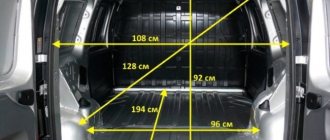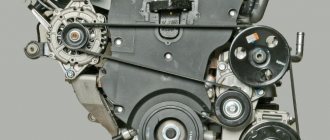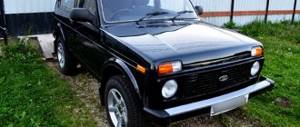Design
It would seem that a lot of time has passed since the debut of the three-door. However, in 1993, the designers decided not to change the appearance of the car. Thus, the new model 2131 was born in the guise of the still old Niva 2121. The reader can see what the extended modification looks like in the photo below.
The 5-door Niva is a car that has the same design as the three-door. At the front there is a classic black grille and round headlights. At the top there is a rectangular block with dimensions and turn signals. The hood, like on classic Zhiguli cars, opens away from the driver. By default, the car is equipped with 16-inch iron wheels. The only differences in design are a couple of doors with “Zhiguli” handles. Otherwise, the car is identical to model 2121.
Do-it-yourself engine tuning 2106
Engine NIVA 2121 1.6 l. this is a continuation of the 2103 engine and, in turn, the engine from 2101. The main differences between the VAZ 2106 engine and 2103 are pistons with an increased diameter to 79 mm; the 2106 engine block remains the same. The NIVA 1600 engine also has its own crankcase and oil pump. On the left side, to the left of the fuel pump, there is a place where the engine number 2106 is stamped.
The 2106 engine itself is a carburetor inline 4-cylinder with an overhead camshaft, the timing belt 2106 has a chain drive, a double-row chain, 116 links. The motor belongs to the so-called “classic” series with a high block. The service life of the motor, with careful operation and timely maintenance, exceeds the factory-set 125 thousand.
km and reaches 180-200 thousand km. Despite this, this engine is popularly considered less reliable than the engine from 2103. To extend the life of the engine, timely oil changes and pre-warming before driving are important. In winter, warming up the VAZ 2106 engine lasts about 5 minutes at 1500-2000 rpm, as soon as it starts to idle, you can drive.
Let's start with the oil, untimely oil change in the 2106 engine or saving and using low-quality oil leads to the fact that after a run of 60,000 km, the cylinder diameters will increase by 0.15 mm, forget about cheap oils. In addition, it often happens that the VAZ 2106 engine consumes more than a liter of oil per 1000 km.
In this case, we measure the compression and, based on this, determine the malfunction. On NIVA 1600 engines there is a problem of increased wear of the camshaft. Like all previous Zhiguli engines, this VAZ 2106 engine needs valve adjustment, each maintenance is 10 thousand km, a loud knocking sound when the engine is idling, heard from the driver’s seat with the hood closed, indicates exactly this.
Also interesting: Niva engines
We can talk about sounds and knocking in six engines forever, in addition to the above-mentioned valves, the main causes of noise in the VAZ 2106 engine include detonation, why the engine detonates - low-quality fuel, carbon deposits in the combustion chamber and incorrect ignition setting, adjust the ignition, pour normal gasoline and the problem disappears.
Does the engine knock making a metallic sound? These are piston pins or connecting rod bearings; you need to urgently go to a service center.
Does the sound appear while the engine is warming up and is it similar to the knocking of clay dishes? The problem is in the pistons, you can slowly get to the service station. A knock in the VAZ 2106 engine coming from the bottom of the engine simultaneously with a drop in oil pressure indicates a problem with the main bearings, we turn off the car and go to the service in tow.
If the noise is more like a creaking sound in the VAZ 2106 engine, check the tensioner and timing chain tensioner; if there is a grinding noise, check the pump bearing. Unstable operation of the VAZ 2106 engine is common on carburetor cars; clean the carburetor jets.
If the VAZ 2106 engine stalls at idle, while the idle speed is adjusted normally, adjust the air damper.
If it stalls while driving, the reason is in the power supply or ignition system. Is the 2106 engine heating up or boiling? We check the thermostat, radiator, possibly the air in the cooling system, these are the main points causing overheating.
Trouble with VAZ 2106 engine? The main reasons: the valves were adjusted incorrectly, the valve burned out, the cylinder head gasket failed, this will be indicated by the jumping temperature of the coolant, increased smoke from the exhaust system (white smoke). The reasons for engine tripping also include low-octane gasoline, an incorrectly adjusted carburetor, the same carburetor can be the reason why the VAZ 2106 engine jerks, but if it holds idle, look at the ignition system.
Does the VAZ 2106 engine smoke a lot? These are oil scraper rings or valve seals, take the car to a service center and get ready for a major overhaul. Pay attention to the engine mounts, they can cause engine vibration; if the mounts are worn out, go to a service station to replace them. In addition, engine vibration can be caused by an imbalance of the crankshaft and driveshaft, different pistons and other reasons. All this is diagnosed and eliminated in the service conditions.
and 1.8l.
Dimensions, ground clearance
What are the dimensions of the 5-door Niva? The length of the old and new Niva is different. So, in the first case, this parameter is 4.22 meters, in the second – 4.14. The reason for this was the new bumpers. Otherwise, the dimensions of the body do not differ, since its architecture has not changed at all. So, the width of the car is 1.69 meters, height – 1.64. The curb weight of the extended Niva is 1.35 tons. At the same time, the car can take on board up to 500 kilograms of cargo (luggage plus passengers).
As for ground clearance, its value is 20.5 centimeters on standard 16-inch wheels. As owner reviews note, the 5-door Niva, although longer than the three-door, behaves very confidently in mud and swamps. In terms of cross-country ability, this car deserves the highest praise.
5-door Niva: interior
Let's move inside the Niva car. As you know, this SUV was created on the basis of the classic Zhiguli, so it is not surprising that many parts were borrowed from there. As for the interior, you can see the panel and steering wheel from the VAZ-2107. In terms of noise insulation, the Niva, of course, is far from being a leader. Many owners de-noise the body themselves by disassembling the interior down to the screw.
With the advent of the new Urban model, the situation has changed for the better, but not significantly. The instrument panel is now positioned from the “ten”, the steering wheel has a more convenient shape. The panel has changed slightly, but overall retains its angular features.
The only advantage worth noting is that it has a better level of equipment. "Niva" 5-door has electric windows, as well as electric mirror adjustment. But as owner reviews note, the 5-door Niva, even in its maximum configuration, is not equipped with music. This upsets many buyers. It is also worth noting the very noisy operation of the stove. There is no air conditioning here.
What distinguishes the long-wheelbase Niva from the short one is the rear row. The architecture of the seats here is the same, but the distance to the apron of the seats is an order of magnitude greater. Rear passengers will not feel cramped, unlike the three-door Niva. In this regard, the five-door deserves praise.
5-door Niva: technical specifications
Under the hood of the car is a 1.7-liter engine. Initially it was carburetor. The maximum engine power is 82 horsepower. The same engine was also installed on the Soviet short-wheelbase Niva. As the owners' reviews note, the 5-door Niva with this engine did not have the best dynamics characteristics. Acceleration to hundreds took more than 20 seconds. Fuel consumption is about 14 liters per 100 kilometers. The engine life is from 100 to 200 thousand kilometers.
In the 2000s, the car began to be equipped with an injection power unit. Essentially, this is the same engine, but with distributed injection. The maximum power of the unit is 83 horsepower. One of the positive changes is more economical fuel consumption. The car began to consume 1-2 liters of gasoline less. In terms of dynamics, the car has improved slightly, but the owners do not feel any noticeable changes. It took about 19 seconds to accelerate this car to hundreds. And the maximum speed is 137 kilometers per hour. However, the cruising speed is 80 kilometers per hour. As owner reviews note, driving a Niva at higher speeds is not very comfortable.
As for the transmission, there was only one. This is a five-speed manual. Additionally, the car was equipped with a transfer case with a reduction gear. Among the shortcomings, reviews note the big noise of the box. However, this problem occurs in almost all VAZ cars.
Some people install gas equipment on their car in order to save money on fuel. As reviews note, the car feels great on gas. Since the engine is an old design, a second-generation LPG is sufficient. Gas consumption is approximately the same (may increase by one and a half liters), and the engine output is the same.
Advantages and disadvantages of a diesel engine
If the manufacturer does not provide the opportunity to buy a Lada 4×4 with a diesel engine, then craftsmen will appear who will install it with their own hands. So, which diesel engine is suitable for the VAZ 2121? Here are the most popular models:
- Peugeot XUD-9SD (1.9 l, about 70 hp) together with Fiat Polonez gearbox.
- Peugeot XUD 11 with Fiat Polonez gearbox.
- Toyota 3C (79 hp) or 3ST (100 hp) together with Toyota Noah gearbox.
- Motor from Volkswagen Vento.
- And many others.
To install a diesel engine, a large number of modifications will be required. The simplest and most common way of such tuning is to use the engine that was installed for export versions of the SUV (XUD-9SD). Its installation requires the least amount of changes to the machine design. It has a good location of the oil intake (in the front, not in the center or rear), the oil filter (on the front left, like the Lada 4x4) and attachment points to the body. In addition, it is easy to find spare parts for this engine model. The approximate procedure is as follows:
- Engine mounts are suitable for VAZ 21215.
- The gearbox bell and the box itself fit well from Fiat Polonez.
- Rework the pan, oil intake, flywheel, exhaust system, etc.
- The easiest way is to complete all the modifications according to the documents.
In other words, no diesel engine can be installed instead of a gasoline engine without modifications. What do you think, is it necessary to change the Lada 4×4 internal combustion engine to a diesel one? If yes, which one and why? Let us remind you that you can improve off-road performance in an easier way, for example, by installing mud tires.
Also interesting: Engine VAZ 21213 Niva
Keywords: 4x4 engine | 4x4 gearbox
Found an error? Select it and press Ctrl Enter..
- Which car brands have the highest share of corporate sales?
- What is the real acceleration to hundreds and the maximum speed of the Lada Vesta Sport
- Installation and connection of fog lights on Lada 4×4 (VAZ 2121, 2131)
- Is it worth installing a diesel engine on Lada 4×4 (VAZ 2121, 2131)
Read news about the new Niva
- Niva Chevrolet alarm connection points
- Pros and cons of the Chevrolet Niva car suspension
- Which carburetor to install on Niva 21213: recommendations - Website about the domestic automobile industry
- Chevrolet Niva won't start; the starter doesn't turn: it just clicks.
- Wiring diagram VAZ-21213 Niva VAZ 21213, 21214, 2131 lada 4×4
- How to disable abs on a Chevrolet Niva || New Niva what is abs
- Installation and repair of the VAZ 2121 Niva transfer case
- Black Niva Urban (Panther color)
Car chassis
The suspension architecture here is the same as that of the three-door Niva. The main difference between the Niva and other Soviet and Russian SUVs was the lack of a frame. The car has a monocoque body made of high-strength steel.
At the front there is an independent suspension with coil springs, wishbones and hydraulic shock absorbers. At the rear there is a dependent lever design. The steering was initially not equipped with power steering, but with the release of Urbana the situation changed for the better. Brakes are discs at the front and drums at the rear. The brakes on the Niva are of average quality. There are generally enough of them for the city, the owners say.
How does this car behave on the move? As reviews note, the car has a fairly comfortable suspension. The car handles potholes well, because unlike other SUVs in the USSR, there are no springs even at the rear. In addition, the long wheelbase adds comfort. But there are also disadvantages. Since the car has a high center of gravity and a soft suspension, it rolls a lot when cornering. Owners also note strong play in the steering wheel. All VAZs of the classic family have this feature. There is no point in trying to improve the steering. It's expensive and hard. The suspension is modified only for the purpose of lifting, to install wheels of larger diameter.
Weaknesses of the VAZ 21214 engine
Cylinder block. This weak point appears on various models of Nivov engines, including the previously discussed 21213. Due to insufficient quality control, the assembly unit is manufactured with a high percentage of factory defects. In short, the drilling depth of the intake manifold stud holes is not maintained, causing the holes to meet the camshaft stud holes.
In this way, L-shaped through channels are obtained. After installing the studs at the factory, the connections remain sealed for some time and the problem is not identified when the quality control department employees accept engine tests. After the sale of new cars with low mileage, during sharp braking, oil begins to seep through the studs onto the hot intake manifold, so much so that smoke from the oil burning in the manifold pours out from under the hood, and accordingly, there is nothing to breathe in the cabin.
A sketch for the technical specifications for eliminating oil leaks from under the exhaust manifold studs.
- Remove the GC cover;
- Unscrew the two studs securing the bearing housing (see sketch) and remove oil from the threaded holes;
- Thoroughly degrease the holes and stud;
- Apply sealant UG-10 or its analogues to the lower threads of the studs;
- Place the studs in place;
- Tighten the bearing housing nuts;
- Install the cylinder head cover;
- Wait at least 30 minutes for the sealant to set.
- Water pump;
- Engine, manual transmission and transfer case oil seals;
- Generator;
- Starter;
- manual transmission;
- Valve cover gasket;
- Cooling system pipe connections;
- Radiator;
- Thermostat;
- Expansion tank;
- Vacuum brake booster.
Also interesting: What kind of diesel engine can be installed on the Niva?
The water pump (pump) is characterized by frequent failures on new cars after 2,000 km.
Due to poor quality, oil seals require more frequent replacement than required according to the operating manual.
The generator has a high probability of failure. As a rule, it burns out even on new cars that have not reached 4,000-10,000 km.
The starter has a low service life without repair.
On a gearbox, one of the common defects is the fifth gear slipping out. In addition, the gears are not fully engaged.
The valve cover gasket loses its properties over time and allows oil to leak out.
The connections of the cooling system pipes in the places where the clamps are installed are not reliable and lose their tightness very early, which is fraught with loss of antifreeze.
The radiator is leaking. The problem occurs due to the appearance of cracks in the radiator pipe package, accompanied by loss of coolant. This defect has become widespread.
The thermostat does not provide thermal conditions for the coolant in the engine cooling system. The manifestation of this problem is no exception. The cause of the defect is a failure of the valve mechanism inside the thermostat. To check that the thermostat is working properly, after starting the engine, simply place your palm on the lower (outlet) hose, through which hot antifreeze circulates into the radiator for cooling. If the thermostat is working properly, after some time the hose should become hot; if the hose remains cold, the thermostat must be replaced.
The expansion tank cracks and antifreeze leaks out. The appearance of cracks occurs due to the failure of the steam-air valve in the tank plug due to increased pressure.
Vacuum brake booster (VUT). Manifested by a stiff brake pedal. The speed may fluctuate when the brake pedal is pressed, as well as hissing. The problem is solved by replacing failed rubber products and replacing clamps in connections.
Let's sum it up
So, we looked at what the all-wheel drive five-door Niva is. Among the positive aspects of the car it is worth emphasizing:
- Simplicity of design (accordingly, it can be repaired in most cases without the help of mechanics).
- Patency. Already in the basic configuration there is a locking and reduction gear.
- Spacious interior (compared to the short-wheelbase version).
- Soft suspension.
But this car also has disadvantages. Among them it is necessary to highlight:
- Weak motors.
- High fuel consumption.
- Body prone to corrosion.
- Poor sound insulation.
- Poor directional stability.
Who is this car suitable for? Niva is a good choice for those who need a simple and cheap all-wheel drive SUV for off-pavement driving. It is for such purposes that in most cases it is purchased. There is no point in buying a car and using it purely in the city. In summer it is hot, it is clumsy, and it eats a lot of fuel. For the city, it is better to choose something from the front-wheel drive VAZ family (for example, the “ten”, which will be cheaper to operate and more maneuverable in the city).











